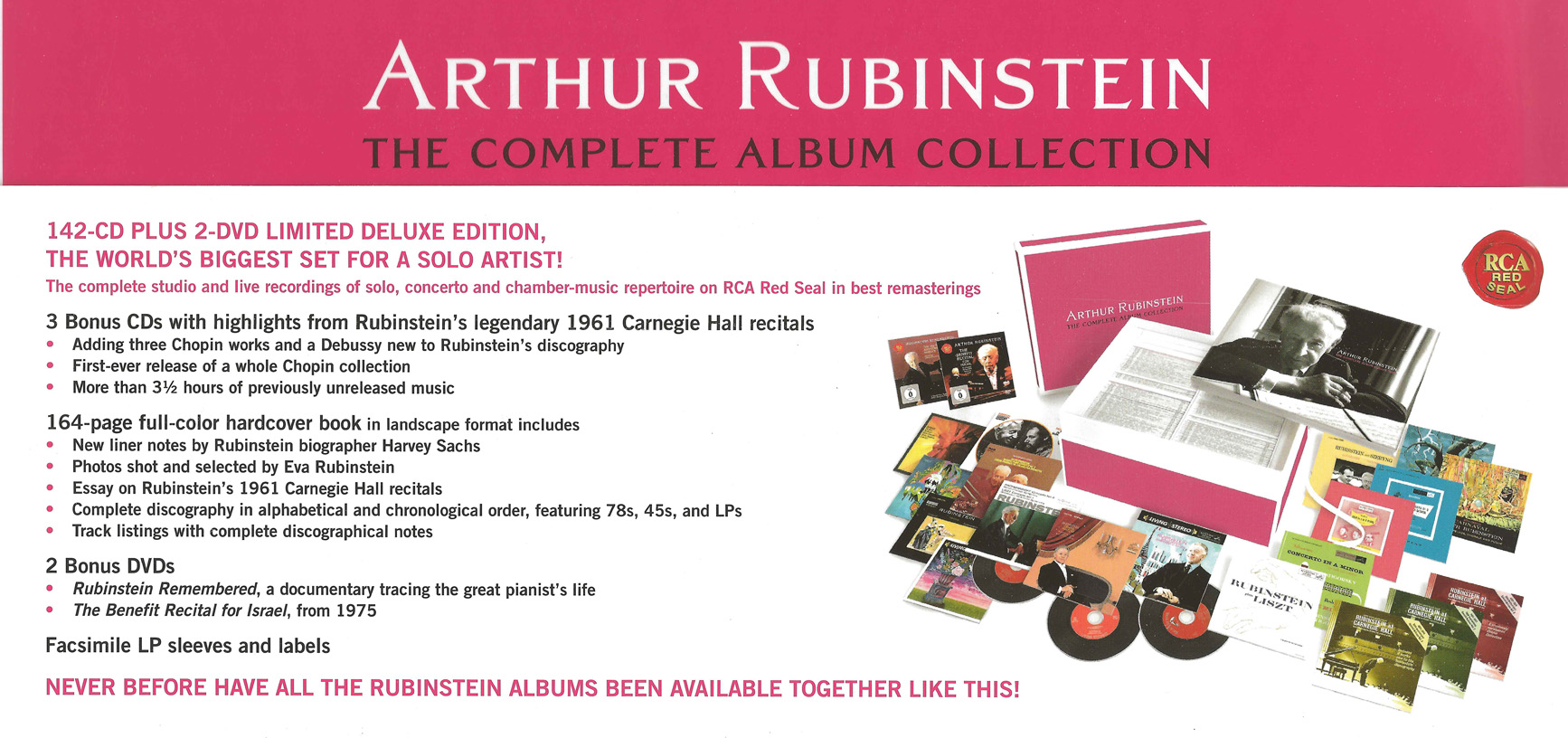Ludwig van Beethoven
Sonata for Piano and Violin No.8 in G major, op.30/3
Media Review / Comparison
2012-01-03 — Original posting (on Blogger)
2013-07-15 — New standard layout applied
2014-05-10 — Added reference to CD from Rubinstein Album Collection
2014-10-31 — Re-posting as is (WordPress)
2016-06-23 — Brushed up for better readability
Table of Contents
Introduction
This is another note on the recordings of Beethoven’s sonatas for piano & violin in my music collection, about the sonata in G major, op.30/3 — references to the CDs are given at the bottom of the respective section, or in one of the related postings, or see the summary on the postings covering Beethoven’s Sonatas for Piano & Violin.
Below you find my comments on the recordings that I have for the Sonata for Piano and Violin No.8 in G major op.30/3 by Ludwig van Beethoven (1770 – 1827). Here’s a short list of the recordings in this comparison, in alphabetic order:
- Renaud Capuçon & Frank Braley (2009)
- Isabelle Faust & Alexander Melnikov (2008)
- Arthur Grumiaux & Clara Haskil (1957)
- Gidon Kremer & Martha Argerich (1994)
- Yehudi Menuhin & Wilhelm Kempff (1970)
- David Oistrakh & Lev Oborin (1962)
- Itzhak Perlman & Vladimir Ashkenazy (1975)
- Henryk Szeryng & Arthur Rubinstein (1961)
The Movements
The movements in this sonata are
- Allegro assai (6/8)
- Tempo di Minuetto, ma molto moderato e grazioso (3/4)
- Allegro vivace (2/4)
The (measured) metronome numbers are approximate values only.
Comments on the Interpretations
Yehudi Menuhin, Wilhelm Kempff (1970)
Beethoven, The Complete Violin Sonatas, Vol.II: Sonatas opp.30, 47, 96
Yehudi Menuhin, Wilhelm Kempff
DG 459 436-2 (stereo, 2 CD); ℗ 1970

Yehudi Menuhin and Wilhelm Kempff (1970) — for general comments see op.30/1
Comments on the Performance
- 6’44”; 3/8 = 88
The tempo is slightly better (faster / less slow) than with Oistrakh / Oborin. The articulation (primarily in the violin) is not always careful / accurate, there are rushed passages. - 8’04”; 1/4 = 78
The tempo is better than with Oistrakh / Oborin — on the other hand, there are some intonation issues, the coordination is occasionally shaky (e.g., when the violin plays 4 beats over triplets in the piano part), the vibrato is a bit nervous, some excessive portamenti. - 3’58”; 1/4 = 115
Often clumsy — a slow Allegretto.
| Recommendation: | No |
| Rating: | 2.0 (2 / 2 / 2) |
David Oistrakh, Lev Oborin (1962)
Beethoven: The Sonatas for Piano and Violin (opp. 12, 23, 24, 30, 47, 96)
Philips 468 406-2 (stereo, 4 CD); ℗ 2001

David Oistrakh and Lev Oborin (1962) — for CD information and general comments see op.12/1
Comments on the Performance
- 7’18”; 3/8 = 80
Rather slow: just about allegretto; emotions are too controlled. At the transition to the second theme, why are the pp sections taken slower (or played as a fermata)? This interrupts the musical flow! - 9’27”; 1/4 = 68
Too slow — adagio, not tempo di minuetto, very static; the violin sounds almost as played con sordino, ornaments and accompaniment are played as melody. - 3’25”; 1/4 = 135
OK, but could/should be a bit more vivid: somewhat too controlled
| Recommendation: | No |
| Rating: | 2.3 (2 / 2 / 3) |
Henryk Szeryng, Arthur Rubinstein (1961)
Beethoven: Violin Sonatas Nos. 5, 8, 9 (opp.24, 30/3, 47)
Henryk Szeryng, Arthur Rubinstein (1961)
RCA Victor / BMG 09026 63040-2 (stereo); ℗ / © 2003

Arthur Rubinstein — The Complete Album Collection
CD #80: Beethoven: Kreutzer & Spring Sonatas
Arthur Rubinstein, Henryk Szeryng (1961)
SONY Classical 88691936912 (142 CDs / 2 DVDs, mono / stereo); ℗ / © 2011
Documentation 162 pp., track listing on CD sleeve

Arthur Rubinstein and Henryk Szeryng (1961) — for general comments see op.24
Comments on the Performance
- 4’30” (exposition not repeated); 3/8 = 92
Rushed passages (sixteenths) in the piano, the articulation is not careful (on both parts), Szeryng’s vibrato is way too strong. - 8’08”; 1/4 = 82
The vibrato is too strong and too nervous, excessive portamenti, loses intensity and focus, some odd tempo variations / alterations. - 3’28”; 1/4 = 140
The articulation is (sounds) coarse, rough, sometimes almost careless.
| Recommendation: | No |
| Rating: | 2.3 (2 / 3 / 2) |
Arthur Grumiaux, Clara Haskil (1957)
Beethoven: Violin Sonatas, Complete (opp. 12, 23, 24, 30, 47, 96)
Brilliant Classics 93329 (mono, 3 CD); licensed from Decca

Arthur Grumiaux and Clara Haskil (1957) — for CD information and general comments see op.12/1
Comments on the Performance
- 6’06”; 3/8 = 104
Fast — but given the bad acoustics (reverberation, mono recording, microphone placement), the tempo should really be slower, also because several passages appear rushed / pushed. Further, in fast passages the piano is too loud, dense and dominating, leading to a lack in transparency. - 7’51”; 1/4 = 81
The balance (for a change!) is better than with Perlman / Ashkenazy — faster, but without “internal unrest”. But also here, the vibrato is too nervous for a slow movement. - 3’29”; 1/4 = 140
OK, the sound balance (for once!) gives the piano a better chance of being heard. A little more transparency would not hurt.
| Recommendation: | — |
| Rating: | 3.3 (3 / 4 / 3) |
Itzhak Perlman, Vladimir Ashkenazy (1975)
Beethoven: The Violin Sonatas, Complete (opp. 12, 23, 24, 30, 47, 96)
Itzhak Perlman, Vladimir Ashkenazy
Decca 421 453-2 (stereo, 4 CD); ℗ 1974 / © 1988

Itzhak Perlman and Vladimir Ashkenazy (1975) — for CD information and general comments see op.12/1
Comments on the Performance
- 6’38”; 3/8 = 94
Dramatic, emotional, good agogics, articulation, phrasing; keep the tension. Perlman even holds back his vibrato; one of the best movements with these artists (so far, in this series). - 7’58”; 1/4 = 78
Ashkenazy’s piano accompaniment is too much in the foreground, dominating; also, even though the tempo is not excessive, there is some unrest in this interpretation that does not fit a Tempo di Minuetto, ma molto moderato e grazioso. - 3’25”; 1/4 = 140
Good! Vivid, with liveliness and good agogics, the artists appear to have fun with this!
| Recommendation: | OK, except for the slow movement |
| Rating: | 3.7 (4 / 3 / 4) |
Renaud Capuçon, Frank Braley (2009)
Beethoven: Complete Sonatas for Violin & Piano (opp. 12, 23, 24, 30, 47, 96)
Virgin Classics LV 7873 (stereo, 3 CD); ℗ / © 2010


Renaud Capuçon and Frank Braley (2009) — for CD information and general comments see op.12/1
Comments on the Performance
- 6’17”; 3/8 = 102
Good, but the articulation is not always consistent between the two artists; Braley could/should sometimes articulate better (lacking some agility?). - 7’32”; 1/4 = 84
Sometimes there is some slight unrest (not as bad as with Perlman / Ashkenazy, though), and the agogics are not always well-coordinated between the artists. - 3’33”; 1/4 = 140
Good, though the accents / sforzati could be more pronounced.
| Recommendation: | OK |
| Rating: | 4.0 (4 / 4 / 4) |
Gidon Kremer, Martha Argerich (1994)
Beethoven: Violin Sonatas Nos. 6 – 8 (op. 30)
DG 445 652-2 (stereo); ℗ / © 1994

Gidon Kremer and Martha Argerich (1994) — for general comments see op.30/1
Comments on the Performance
- 6’21”; 3/8 = 100
Excellent, dramatic, with the usual presence & alertness, full of life (just listen to the exchanges of trills between the two artists!), yet with controlled articulation, transparent, clear! - 8’32”; 1/4 = 80
An excellent interpretation. Kremer / Argerich master the key difficulty in this movement: the piano is critical to keeping / maintaining the calm, serene mood also through more dramatic sections, without introducing “internal unrest” as with some of the interpretations above.Very good articulation, agogics & dynamics. - 3’24”; 1/4 = 140
Again excellent in phrasing, agogics, dynamics, and presence / alertness.
| Recommendation: | Yes! |
| Rating: | 5.0 (5 / 5 / 5) |
Isabelle Faust, Alexander Melnikov (2008)
Beethoven: Complete Sonatas for Piano & Violin (opp. 12, 23, 24, 30, 47, 96)
Isabelle Faust, Alexander Melnikov
Harmonia mundi HMC 902025.27 (stereo, 3 CD + 1 CD/DVD); ℗ 2009

Isabelle Faust and Alexander Melnikov (2008) — for CD information and general comments see op.12/1
Comments on the Performance
- 5’56”; 3/8 = 108
Excellent again! Faust and Melnikov are exploring the tempo limits, but the articulation remains controlled — presence, phrasing, dialogs, transparency/clarity remain impeccable! - 6’10”; 1/4 = 100
At first, this feels “very fast” — until one realizes that this is proper “Tempo di Minuetto“, a dance, after all! This is simply excellent: there are so many new details to discover, in the sforzati, the phrasing and the articulation. And this interpretation reveals that this movement is not just contemplative! - 3’04”; 1/4 = 154
Faust / Melnikov start off faster than all others, and they sometimes even accelerate to 1/4 = 160 — yet, it is all carefully and precisely articulated in both instruments, the coordination between the artists is just perfect!
| Recommendation: | YES! |
| Rating: | 5.0 (5 / 5+ / 5) |
Addendum
If you are not an active pianist or violinist, you might want to follow this music using a pocket score — these typically come in two volumes:
- Sonatas op.12/1 – 3, op.23, op.24 —Find pocket score (Kalmus) on amazon.com (#ad) —
- Sonatas op.30/1 – 3, op.47, op.96 —Find pocket score (Kalmus) on amazon.com (#ad) —
While musicians, of course, prefer a full size score edition, such as Henle’s, also in two volumes:
- Sonatas op.12/1 – 3, op.23, op.24 —Find full score (Henle) on amazon.com (#ad) —
- Sonatas op.30/1 – 3, op.47, op.96 —Find full score (Henle) on amazon.com (#ad) —




















